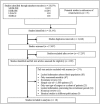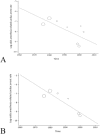Perioperative and anesthesia-related cardiac arrests in geriatric patients: a systematic review using meta-regression analysis
- PMID: 28572583
- PMCID: PMC5453984
- DOI: 10.1038/s41598-017-02745-6
Perioperative and anesthesia-related cardiac arrests in geriatric patients: a systematic review using meta-regression analysis
Abstract
The worldwide population is aging, and the number of surgeries performed in geriatric patients is increasing. This systematic review evaluated anesthetic procedures to assess global data on perioperative and anesthesia-related cardiac arrest (CA) rates in geriatric surgical patients. Available data on perioperative and anesthesia-related CA rates over time and by the country's Human Development Index (HDI) were evaluated by meta-regression, and a pooled analysis of proportions was used to compare perioperative and anesthesia-related CA rates by HDI and time period. The meta-regression showed that perioperative CA rates did not change significantly over time or by HDI, whereas anesthesia-related CA rates decreased over time (P = 0.04) and in high-HDI (P = 0.015). Perioperative and anesthesia-related CA rates per 10,000 anesthetic procedures declined in high-HDI, from 38.6 before the 1990s to 7.7 from 1990-2017 (P < 0.001) and from 9.2 before the 1990s to 1.3 from 1990-2017 (P < 0.001), respectively. The perioperative CA rate from 1990-2017 was higher in low-HDI than in high-HDI countries (P < 0.001). Hence, a reduction in anesthesia-related CA rates over time was observed. Both perioperative and anesthesia-related CA rates only decreased with a high-HDI between time periods, and perioperative CA rates during 1990-2017 were 4-fold higher with low- compared to high-HDI in geriatric patients.
Conflict of interest statement
The authors declare that they have no competing interests.
Figures





Similar articles
-
Anesthesia-Related and Perioperative Cardiac Arrest in Low- and High-Income Countries: A Systematic Review With Meta-Regression and Proportional Meta-Analysis.Medicine (Baltimore). 2015 Sep;94(36):e1465. doi: 10.1097/MD.0000000000001465. Medicine (Baltimore). 2015. PMID: 26356701 Free PMC article.
-
Mortality and cardiac arrest rates of emergency surgery in developed and developing countries: a systematic review and meta-analysis.BMC Anesthesiol. 2024 May 20;24(1):178. doi: 10.1186/s12871-024-02559-w. BMC Anesthesiol. 2024. PMID: 38769493 Free PMC article.
-
Perioperative mortality in older patients: a systematic review with a meta-regression analysis and meta-analysis of observational studies.J Clin Anesth. 2021 May;69:110160. doi: 10.1016/j.jclinane.2020.110160. Epub 2020 Dec 15. J Clin Anesth. 2021. PMID: 33338975
-
Global anaesthesia-related cardiac arrest rates in children: a systematic review and meta-analysis.Br J Anaesth. 2023 Nov;131(5):901-913. doi: 10.1016/j.bja.2023.08.023. Epub 2023 Sep 22. Br J Anaesth. 2023. PMID: 37743151
-
An update on the mechanisms and risk factors for anesthesia-related cardiac arrest in children: a narrative review.Braz J Anesthesiol. 2024 Sep-Oct;74(5):844519. doi: 10.1016/j.bjane.2024.844519. Epub 2024 May 27. Braz J Anesthesiol. 2024. PMID: 38810776 Free PMC article. Review.
Cited by
-
Perioperative and anesthesia-related cardiac arrest and mortality rates in Brazil: A systematic review and proportion meta-analysis.PLoS One. 2020 Nov 2;15(11):e0241751. doi: 10.1371/journal.pone.0241751. eCollection 2020. PLoS One. 2020. PMID: 33137159 Free PMC article.
-
False-negative frozen section of sentinel nodes in early breast cancer (cT1-2N0) patients.World J Surg Oncol. 2021 Jun 22;19(1):183. doi: 10.1186/s12957-021-02288-1. World J Surg Oncol. 2021. PMID: 34158071 Free PMC article.
-
Incidences and factors associated with perioperative cardiac arrest in trauma patients receiving anesthesia.Risk Manag Healthc Policy. 2018 Oct 18;11:177-187. doi: 10.2147/RMHP.S178950. eCollection 2018. Risk Manag Healthc Policy. 2018. PMID: 30425598 Free PMC article.
-
Global mortality of children after perioperative cardiac arrest: A systematic review, meta-analysis, and meta-regression.Ann Med Surg (Lond). 2022 Feb 3;74:103285. doi: 10.1016/j.amsu.2022.103285. eCollection 2022 Feb. Ann Med Surg (Lond). 2022. PMID: 35242308 Free PMC article. Review.
-
Anesthetic management of geriatric patients.Korean J Anesthesiol. 2020 Feb;73(1):8-29. doi: 10.4097/kja.19391. Epub 2019 Oct 22. Korean J Anesthesiol. 2020. PMID: 31636241 Free PMC article. Review.
References
-
- WHO (World Health Organization). Ageing. http://www.who.int/topics/ageing/en/ (2016).
-
- WHO (World Health Organization). Ageing and health. http://www.who.int/mediacentre/factsheets/fs404/en/ (2015).
Publication types
MeSH terms
LinkOut - more resources
Full Text Sources
Other Literature Sources
Medical

